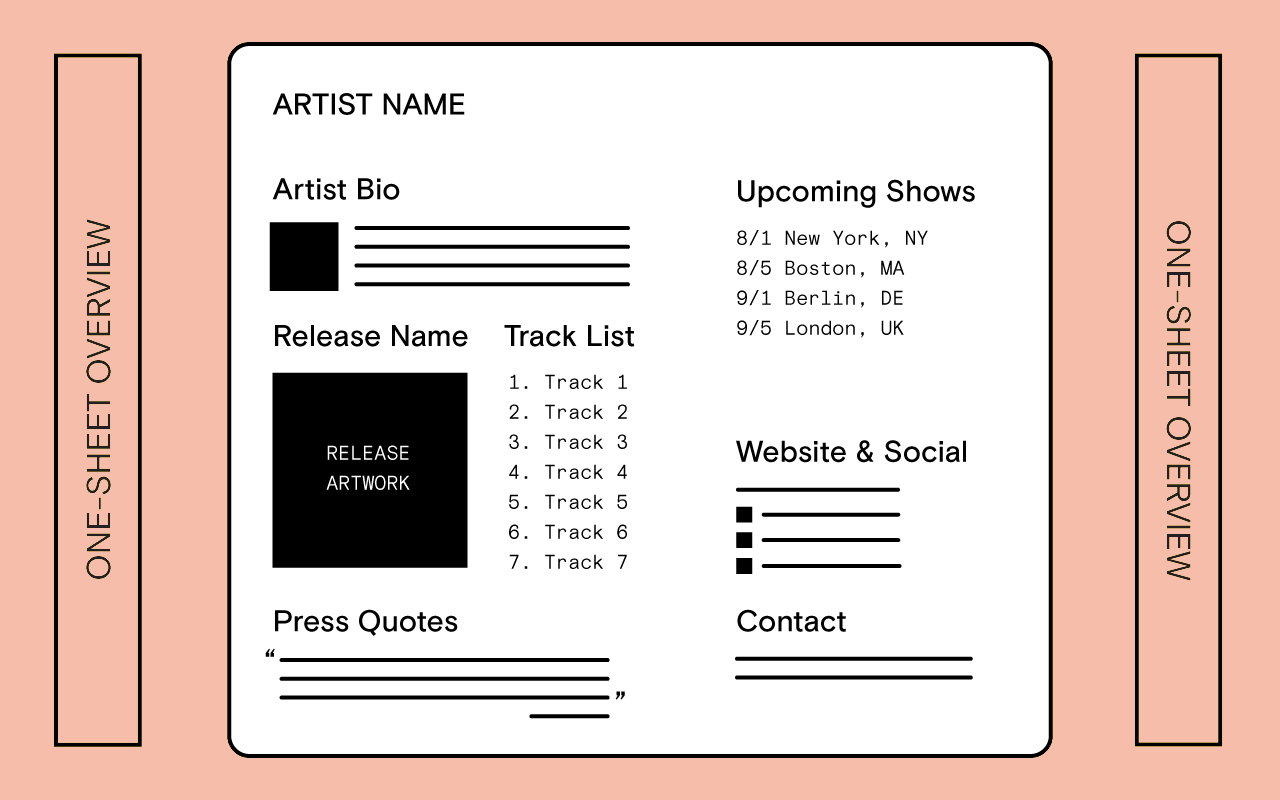In a crowded digital landscape, developing and maintaining a “brand” can give you a competitive advantage needed to stand out as a musician. A distinct brand message around your musical identity will become an integral part of how your story is told throughout all stages of growth.
Keeping your messaging authentic is a crucial piece to creative development, and can be a powerful conduit in your art and offering.
Your brand messaging includes what and how you communicate on social media, streaming platforms, in the press, or even to promoters and agents.
Think of these 5 key actions when creating your messaging:
1. Defining
2. Communicating
3. Keeping Consistent
4. Leveraging
5. Packaging

1. Define your message.
So, how do you define your message? Brainstorm. Get a whiteboard, notepad, or open up your notes app, and start writing. Be patient — this won’t happen in one magical session. Give yourself the time and freedom to explore all avenues and angles.
Here are a few prompts to get you going:
- Think about the reasons you make music — what is your core purpose?
- What is your story?
- What makes you unique?
- What does your music sound like?
- Where do you come from and how has that influenced your music?
- What do you want people to know about you?
- What do you want listeners to take away from your work?
Take the scribbles and pull out commonalities to incorporate the 5 W’s into your story.
- WHO are you — a solo act? A singer, a producer, a group? How can you be categorized in terms of size?
- WHAT kind of music do you make? This is the feelings part — what is the music doing for listeners?
- WHEN was the music made, and how old were you? This gives the audience some context.
- WHERE are you from? Where is the music inspired from? Where was the music made? In the garden or in a studio?
- WHY did this project come together — what was the precipice for it? Why should we care?
Here’s a detailed example of how you might take the 5 W’s and weave them into a story.
Gemma is a singer/songwriter creating downtempo trip-hop reminiscent of early Portishead. Complete with a city vibe, Gemma’s inspiration comes from the collaborative studio she works out of in Bushwick, Brooklyn. Moving from Oklahoma City in 2010, after breaking up with her long-time partner, she put the ‘Out Here’ EP together bringing in local instrumentalists to help tell a love-lost musical story with their unique instruments. This is Gemma’s first project in her ‘Far Gone’ series which will roll out over the next year in conjunction with live art performances all over New York City. As an on-going effort to use music for good, Gemma is donating 50% of show proceeds to XX Charity that provides production lessons to teenagers in underserved communities.
We will come back to Gemma later.

2. Communicate your message
Once you have the core messaging for your story, it can be communicated in many places:
- Tweaked into a bio for DSPs (Spotify, Apple Music, YouTube, etc.)
- Shortened for social media bios (Instagram, Twitter, Facebook, etc.)
- Used as a backstory for bookers, promoters, and press
Each message will be tailored to the audience you’re speaking to, but once you have the core messaging, it will be easy to adapt your message clearly across platforms.
Don’t forget — your message is communicated visually as well as verbally. To create your visual identity, start by putting together a mood board of different images and visuals that reflect your style and core messages. As your brand develops, so will the aesthetics, but be sure to align the visual messaging with the written messaging. If you’re not sure, get opinions from your support system, and have them weigh-in.

3. Keep consistent with your message
Consistency is key. People should never be confused about your “brand” — your core messages and visuals should remain the same across all platforms.
For example, anywhere you can find Gemma’s Out Here EP, the messaging should be consistent with the core story above. Not only with the hard facts: the spelling of the EP, Gemma’s name, where she is from, but also the more conceptual details: what the project is about, the visuals, etc. Depending on the amount of space you have, the story may need to be revised, but the core messages should remain the same.
The reason for consistency is due to the sheer amount of entry points that there are in the digital landscape. You never know if someone is going to find you on Spotify, Instagram, Facebook, or even YouTube, so the message should always be the same no matter where someone learns about or sees your brand story first.
4. Leverage your messaging
Say a promoter in NYC is interested in booking Gemma – who is also a huge Portishead fan. Since this piece of information is actually relevant to Gemma’s sound (remember her music is very Portishead-like), she would want to leverage this along with the rest of her story to connect with the promoter on a deeper level. While this sounds like common sense, sometimes we forget about leveraging — taking something and using it to get something else.
Always track your stats — know your followers and streaming numbers. You should be able to recall this data at any time and weave it into your story as further leverage. If your numbers are low or still growing, figure out a way to show growth in the form of a percentage increase. (So if you had 1,000 streams in January and 2,000 in February, you can say you’ve “doubled” your streams within a month!)
Leveraging requires some homework. You should always know who you are talking to — whether it’s a record label executive, a booking agent, a fan, or publicist. A quick Google search can help you find out what they are into (but don’t be creepy about it). Not only will it show the person you’re meeting with that you’re serious, but it’s also a good way to break the ice and establish a common ground. At the end of the day, people connect better through genuine and personal connections rather than those stemmed from a business agenda.

5. Package your message
When your first impression may be your only one, presentation is everything. Here are some scenarios where you will need to deliver a clear message to show who you are musically and what you’ve done:
- If you’re talking to labels
- If you’re trying to get press coverage
- If you’re trying to sell yourself to a booking agent or when a booking agent is trying to sell you to a booker
- If you’re trying to get a manager
- If a brand approaches you about a collaboration
Putting things in a nice package will:
- Make you look like a professional, which means more people will take you seriously
- Make other people’s jobs easier if they are passing your information along elsewhere (people are more willing to help if it’s not a hassle for them)
- Help you get organized
- Create a healthy environment for you to bring on collaborators or build your team out
It’s always good to have a one-sheet to share. This is a one page PDF that has everything about you or your band — what you look like, where you’ve played, where to find your music, which press have covered you, and clickable links to your website and social media pages.
If you are more established, your one-sheet will be a bit more robust to include streaming and follower stats and any other strong data points that create more value for you.

Creating a structure from the beginning with strong core messaging will help you establish yourself internally, which in turn, will give you more confidence to be who you want to be and allow you to clearly broadcast that to the world.
With a background at the intersection of entertainment and technology, Jacqueline Schneider has worked across artist management, business development, and communications as a label partner and advisor. She now runs Current Mood, a cultural strategy agency and podcast, and contributes regularly to Forbes and Billboard.
Interested in writing for Level? ↳




